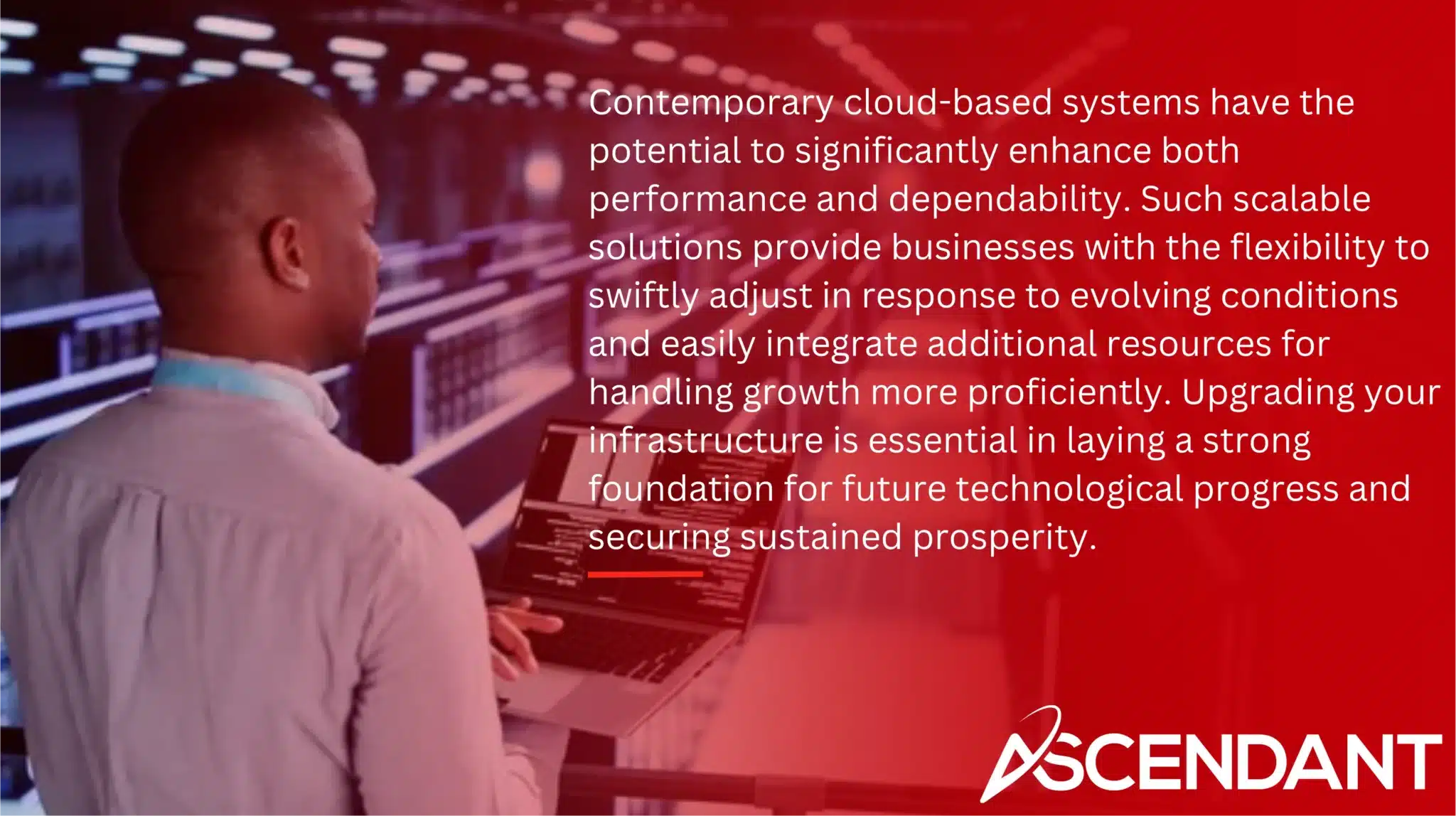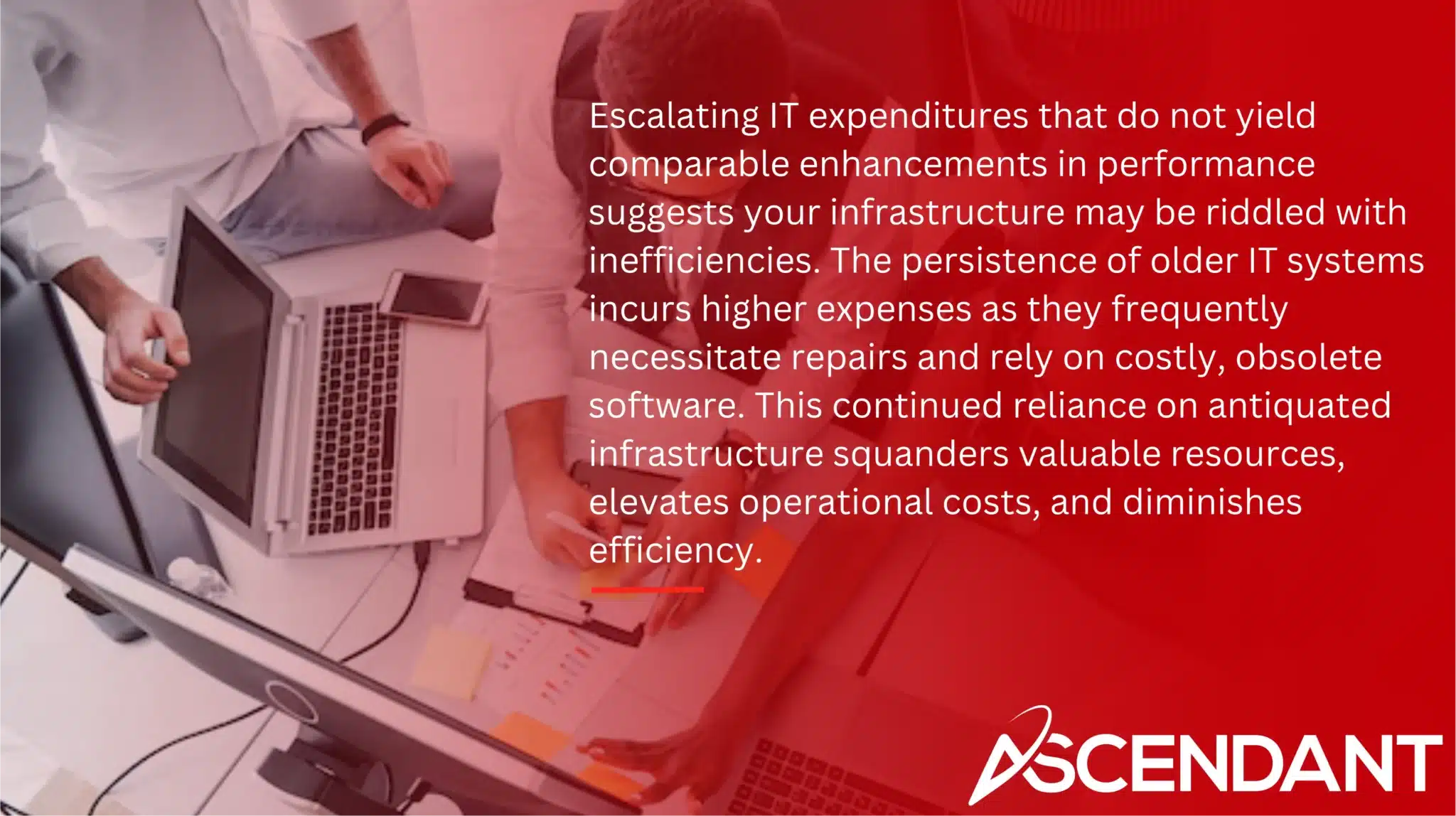Is your business experiencing frequent system crashes or slow performance? These could be signs that you are outgrowing your IT systems. As your business expands, your IT infrastructure must evolve to keep up. This article will help you identify the clear indicators that your business is outgrowing its current IT systems and provide solutions to each of these issues.
In This Article:
- Frequent System Crashes and Downtime
- Slow System Performance and Lag
- Growing Security Concerns
- Limited Scalability and Flexibility
- Rising IT Costs Without Added Value
- Incompatibility with Modern Tools
- Challenges in Supporting Remote Work
- Evaluating Your IT Needs for Future Growth
- Best Practices for Upgrading IT Infrastructure
Key Takeaways
- Frequent system crashes, slow performance, and rising IT costs indicate businesses are outgrowing their IT infrastructure and require upgrades.
- Security concerns grow as outdated systems fail to protect against data breaches, emphasizing the need for modern security practices and proactive strategies.
- Limited scalability and incompatibility with modern tools hinder business adaptability, making investment in flexible, cloud-based solutions essential for future growth.
Frequent System Crashes and Downtime
Frequent occurrences of system crashes and periods of downtime are prominent indicators that your business has surpassed its IT infrastructure capabilities. The existing setup may struggle to keep up with current demands, leading to significant performance issues and regular interruptions in service. This is especially true for legacy systems that often have difficulty coping with substantial data loads and rely heavily on manual interventions, making them prone to failures during times of high usage.
The repercussions of overlooking necessary upgrades to your IT infrastructure can be widespread and persist over time. Experiencing system breakdowns at crucial moments within the operational cycle could lead directly to losing valuable opportunities while also reducing overall productivity levels. Such incidents clearly point out that the current IT framework is overstretched and incapable of managing present workloads efficiently.
To effectively tackle these problems, it’s vital to comprehend their root causes, understand how they impact the business operationally, and familiarize oneself with potential solutions for mitigating such challenges moving forward.
Why It Happens
Regular occurrences of system crashes and downtime can often be traced back to outdated systems buckling under the pressure of accommodating additional users and devices. Legacy systems are particularly susceptible to challenges as they attempt to manage increasing volumes of data, necessitating more frequent updates and maintenance because they are not designed for current efficiencies. These systems may experience reduced performance leading to failures when there is insufficient bandwidth during periods of high data traffic.
Proactively monitoring IT environments for emerging issues plays a critical role in averting significant complications. By consistently tracking the performance of systems, it’s possible to identify areas that cause bottlenecks promptly allowing for quick corrective measures. When storage systems falter in keeping pace with new data production rates, this serves as a clear sign that an upgrade is due.
The Impact on Business
System failures can greatly undermine your business’s ability to capitalize on potential opportunities. Even short periods of system downtime can lead to missed chances and a reduction in work efficiency. Out-of-date IT infrastructure considerably impedes productivity, which could jeopardize the achievement of your business goals and priorities. Recognizing issues with your systems should prompt an evaluation.
Ignoring the need for upgrades in IT infrastructure may incur severe financial repercussions. Escalating costs associated with information technology have the potential to siphon off substantial resources that might be better utilized for fostering innovation or facilitating expansion.
It is essential to ensure continuity within your enterprise and synchronize IT systems with corporate ambitions as a means of maintaining competitiveness during times when the company is experiencing growth.
What You Can Do

Contemporary cloud-based systems have the potential to significantly enhance both performance and dependability. Such scalable solutions provide businesses with the flexibility to swiftly adjust in response to evolving conditions and easily integrate additional resources for handling growth more proficiently. Upgrading your infrastructure is essential in laying a strong foundation for future technological progress and securing sustained prosperity.
It’s imperative that companies allocate funds towards scalable IT strategies, enabling them to scale their resources on-demand while maintaining effectiveness. This tactic reduces the likelihood of regular system crashes and periods when services are unavailable, thus promoting steady, trustworthy functioning of operations.
Slow System Performance and Lag
Continuous sluggish performance and delays in system response suggest that your business’s IT infrastructure may not be meeting the increasing demands of operations. Outdated hardware and insufficient bandwidth frequently cause considerable slowdowns, especially during times of heavy use. These problems can lead to lost opportunities, reduced work efficiency, and consequently a decline in profits.
The growing needs of users coupled with an absence of up-to-date IT solutions exert significant pressure on existing systems. It is essential to tackle these challenges to sustain smooth functioning within the company and facilitate its expansion.
Causes of Slow Performance
Congestion within the network frequently results in sluggish or disrupted connectivity, which can cause delays and irritation. When data processing becomes overly protracted, it could be an indicator of lag within your IT infrastructure that amplifies existing performance complications. When response times to inquiries and problems are lethargic, this might suggest a deficiency in resources and specialized knowledge within your IT team.
Substantial volumes of stored data can considerably hamper both performance and access to applications, causing decelerated responsiveness and diminished productivity. Such inefficiencies stemming from challenges in managing large datasets can contribute to a higher turnover among employees due to their discontentment with the system’s ineffectiveness.
Negative Effects
An antiquated IT infrastructure can lead to reduced employee productivity and morale, as well as considerable security threats. Employees may become exasperated with sluggish systems, which can cause substantial hold-ups in finishing tasks and a downturn in productivity levels. An ineffective IT system can also mean lost opportunities, diminishing the company’s competitive advantage, and causing postponements in delivering services.
When employee satisfaction declines due to faulty technology, there is an increased risk of losing customer loyalty, thereby adversely affecting your company’s financial outcomes.
Solutions
Enhancing system performance can be achieved through the upgrade to faster, more efficient hardware components. Elevating internet bandwidth also serves as a means to bolster overall system efficiency and mitigate lagging. Employing load-balancing measures is beneficial in fine tuning system performance, while constant performance monitoring contributes to seamless operational continuity.
For businesses striving to cater to escalating demands while sustaining effective workflows, it’s critical to invest in technology solutions that are scalable. By adopting an approach of proactive support coupled with frequent upgrades for systems, businesses can circumvent issues related to sluggish performances and delays. This ensures that their IT infrastructure remains consistent with both the emerging trends within the industry and the specific necessities of their business operations.
Growing Security Concerns
As the scale of your business expands, the cybersecurity threats linked to antiquated IT systems also escalate. Issues such as data breaches, malware infections, and a slump in productivity are typical when an IT infrastructure lags behind contemporary security protocols. A rise in security incidents is often a sign that your existing systems might not have sufficient strength to safeguard sensitive information.
It’s essential for upholding both business objectives and organizational prestige to confront these security challenges head-on. By adopting current security measures and forward-thinking approaches, you can alleviate these dangers and secure the integrity of your data.
Reasons for Security Risks
Businesses that fail to consistently update their systems may miss out on crucial security enhancements, leaving them vulnerable to cyber attacks. Outdated systems carry a higher likelihood of possessing security vulnerabilities due to the lack of current protections.
Taking measures against such outdated systems and adopting an active approach towards security are critical actions for reducing potential threats and safeguarding sensitive information from unauthorized access or exposure.
Consequences
Businesses may suffer substantial financial consequences and loss of public confidence due to data breaches. If businesses do not implement sufficient security protocols, they risk legal sanctions for not safeguarding consumer information. The long-lasting effects on customer trust and the reputation of a brand caused by a data breach can hinder the growth and future potential of your business.
Mitigation Strategies
Conducting frequent security evaluations and keeping systems current are essential for minimizing the threat of cyber attacks. The adoption of robust security protocols, including multi-factor authentication, is vital in strengthening the protection around your IT framework to prevent potential security breaches.
Allocating resources toward expandable solutions and forward-thinking security approaches is crucial in guaranteeing that as your business expands, it continues to be secure. This commitment protects confidential information and preserves the confidence of your customers.
Limited Scalability and Flexibility
Outdated IT infrastructure with restricted scalability can impede a business’s capacity to adapt to evolving requirements. When there is trouble incorporating additional users, devices, or services, it reveals that the current systems are antiquated and not designed for effective growth support. To cutting-edge software systems, legacy technology frequently encounters difficulties in integration because they do not easily conform to contemporary standards.
To maintain competitiveness and facilitate smooth operation integration with newer software applications, investing in an IT infrastructure capable of scaling and flexibility is crucial. Utilizing cloud technologies can simplify operations by enabling more straightforward alignment with modern tools and help ensure that your business stays at the forefront of its industry.
Causes of Scalability Issues
Performance drops during peak times indicate inadequate IT infrastructure. This clearly shows that it is not equipped to manage high loads effectively. Legacy systems often have hard limits on capacity, making it difficult to add new users or workstations without significant upgrades. The accumulation of data and the need for business intelligence and analytics can also lead to a need for more storage space.
Struggling with legacy systems is a clear sign that an upgrade is overdue. If your IT provider is overwhelmed by adding resources, they may not be able to scale with your growth. Scalable IT infrastructure is vital for maintaining efficiency and supporting business growth.
Business Impacts
Failing to properly scale IT infrastructure can lead to significant issues that detrimentally impact productivity, security, and ultimately the bottom line of a business. When IT infrastructure is not equipped to handle scaling needs, it becomes challenging for businesses to roll out new products or services efficiently, leading to bottlenecks which in turn delay product introductions and impede overall expansion as they affect both onboarding processes and the timeliness of getting products to market.
It’s crucial for sustained growth and continuity that there is an alignment between IT infrastructure initiatives and the overarching objectives of a business. Business leaders must acknowledge this critical relationship by investing in scalable solutions designed specifically with their organization’s future requirements in mind.
Recommendations
Incorporating systems that are modular has the advantage of bolstering a business’s ability to adapt and expand in sync with future technological advances. By opting for cloud-based solutions, businesses can adjust their resources flexibly to match current requirements. Such scalable options facilitate the efficiency and smooth running of operations as businesses evolve.
Acknowledging five crucial signs at an early stage and committing funds towards adaptable IT infrastructure secures your business’s competitive edge while equipping it to tackle forthcoming obstacles. Tackling compatibility problems alongside slow response times from your IT provider plays a significant role in achieving seamless processes and robust support tailored to your expanding enterprise.
Rising IT Costs Without Added Value

Escalating IT expenditures that do not yield comparable enhancements in performance suggests your infrastructure may be riddled with inefficiencies. The persistence of older IT systems incurs higher expenses as they frequently necessitate repairs and rely on costly, obsolete software. This continued reliance on antiquated infrastructure squanders valuable resources, elevates operational costs, and diminishes efficiency.
Conducting a thorough review of IT-related spending can pinpoint potential savings by trimming maintenance overheads. It is essential to tackle these inefficiencies to guarantee that the investments made in IT are strategically aligned with business goals and confer additional value.
Why Costs Rise
The necessity for repeated fixes and the dependence on antiquated software are notable factors that lead to an increase in IT expenses. Such outdated software delivers little benefit, only serving to intensify the financial strain on businesses. This blend of expensive maintenance and outdated programs highlights the critical requirement for a reassessment of investments in IT infrastructure.
It is crucial to guarantee that your IT infrastructure not only proves cost-effective, but also corresponds with your business’s key priorities, as this plays a vital role in sustaining fiscal health and fostering business growth. A routine evaluation of your information technology expenditures can reveal inefficiencies and potential opportunities for enhancement.
Financial Impact
Elevated expenses in IT can cause financial resources to be redirected from innovative and strategic initiatives. If updates to the IT system are overlooked, there might be a surge in costs, including increased expenditures for labor, which endangers sustained fiscal stability. It’s imperative that your investments in IT infrastructure correspond with your business objectives to preserve economic well-being and facilitate expansion.
By routinely evaluating and auditing the IT framework, you can pinpoint opportunities for cost reduction and enhancement of operational efficiency. Harmonizing your IT support structure with the overarching aims of your business is key to securing financial stability while bolstering enduring growth.
Cost-Effective Solutions
Businesses need to concentrate on scrutinizing their IT expenditures and determining the factors that contribute to increased costs in order to effectively manage them. Conducting frequent audits of IT spending is instrumental in identifying inefficiencies, which enables businesses to recalibrate their technology investments with their overarching objectives. Shifting towards contemporary, proficient solutions plays a pivotal role in lessening the continuous maintenance expenses associated with antiquated systems.
Enhancing your IT infrastructure can amplify return on investment by ensuring that technology investments are more tightly aligned with the dynamic needs of your business. Making sure that these investments are cost-effective and support business objectives is crucial for sustaining financial health and fostering sustained growth.
Incompatibility with Modern Tools
If your IT infrastructure is not integrating well with contemporary tools, it’s a strong indicator that the systems in place might be antiquated. The reluctance to adopt new innovations and adherence to obsolete methods are telltale signs of technological stagnation within businesses. Older infrastructures usually struggle to fulfill current compliance standards because they lack critical functionalities like encryption, access controls, audit trails – which is an alarming red flag.
Should software applications prove incapable of satisfying the evolving demands of your business operations, this necessitates modernizing your IT infrastructure. Ensuring compatibility with up-to-date tools is crucial for preserving operational efficiency and fostering expansion within the business.
Causes of Compatibility Issues
An aging or rigid IT infrastructure can create difficulties when incorporating new technologies, potentially resulting in technological problems. The inability of old hardware to effectively support current software applications may become a significant obstacle. Persisting with obsolete applications might cause operations that demand excessive resources and lead to issues with compatibility.
It is vital for the efficiency of your system to make sure that your IT infrastructure possesses the capacity to flexibly accommodate and adapt seamlessly to fresh tools.
Operational Impact
The inability of older systems to work with new, innovative tools can severely constrain the efficiency of day-to-day operations by hindering process optimization. To preserve productivity and facilitate growth, it is crucial that your IT systems are updated to be compatible with contemporary technologies.
Next Steps
To effectively meet the changing demands of your business, it’s crucial to upgrade your IT infrastructure. Ensuring adherence to industry standards promotes greater interoperability among various systems, which improves collaboration. The ability for seamless integration through APIs and current software platforms enables your business to be more nimble and innovative.
Significant improvements in operational efficiency and the facilitation of business expansion can result from an upgraded IT infrastructure. Keeping your IT systems up-to-date with contemporary tools is essential for preserving efficiency and fostering sustained growth.
Challenges in Supporting Remote Work
An insufficient IT infrastructure can significantly impede the effectiveness of supporting remote or hybrid work models. To guarantee operational efficiency and security, especially given the current setup, there is a critical need for an updated and sturdy IT infrastructure.
Tackling these obstacles is vital to preserving business continuity and facilitating support for remote work arrangements.
Reasons for Remote Work Issues
Legacy IT systems frequently lack the requisite functionalities to ensure secure and adaptable remote access. The ability to flexibly and securely connect from afar is critical for maintaining efficient remote operations. Upgrading to contemporary IT infrastructure can both improve capabilities for working remotely and bolster secure connectivity.
It’s imperative that your IT infrastructure is configured to accommodate remote work, as this is key in preserving productivity levels and catering to an expanding employee base.
Effects on Workforce
Poor remote work systems can lead to a decline in productivity and heightened irritation among workers. It’s vital that your IT infrastructure is equipped to facilitate remote working effectively to preserve the well-being and efficiency of employees.
Tackling these issues is imperative for accommodating an expanding team and safeguarding continuous operations as your business develops.
Improvement Measures
To enhance team communication and project management, investing in cloud-based collaboration tools is imperative. To sustain productivity and support an expanding workforce, it’s vital to back remote work with a strong IT infrastructure.
Evaluating Your IT Needs for Future Growth
Conducting an IT assessment helps identify both weaknesses and areas for enhancement. Strategic planning is essential for mapping your IT infrastructure growth. Technology should align with strategic objectives to ensure efficient operations.
Leaders must recognize the need for upgrades to support long-term growth and compliance. Investing in training and development for the IT team can enhance capabilities for future needs.
Current Infrastructure Assessment
Conducting a thorough evaluation of your IT team’s capabilities, by recognizing both their strengths and areas for improvement, is essential. Ensuring that the IT assessment aligns with your business objectives plays a pivotal role in identifying potential opportunities for expansion. Such alignment between IT assessments and business goals is crucial as it facilitates addressing expected growth, exploring new markets, and adapting to shifts in operational strategy.
Predicting Future Demands
To remain competitive and manage the constant digital changes, a dynamic IT infrastructure is essential. Recognizing its strategic importance allows for turning potential obstacles into chances for expansion and growth.
Strategic Planning
Allocating resources within IT must follow a strategic framework that is meticulously constructed. The prioritization of IT enhancements needs to be managed correctly with an assessment of their possible impact on the objectives of the business.
Ensuring that investments in IT are in harmony with the goals set out for the business will foster sustained expansion and uphold ongoing operations.
Best Practices for Upgrading IT Infrastructure
To ensure the success of an IT infrastructure upgrade, adhering to best practices is indispensable. This critical action must be given due attention. Taking a proactive approach to managing and enhancing your IT infrastructure ensures that you stay abreast of evolving technological advancements. It is also vital to invest in strong security solutions and instruments as a defense against the growing landscape of cyber threats.
Incorporating sophisticated networking technologies along with secure tools for remote access can greatly improve collaboration and efficiency among distributed teams. It might become imperative to recruit additional personnel or appoint a Chief Information Officer (CIO) who can offer strategic guidance for IT departments.
Regular IT Audits
Conducting consistent IT audits is essential for pinpointing areas that require enhancement, revealing potential security threats, and discovering chances for streamlining processes. Once enhancements to your IT infrastructure are made, it’s imperative to carry out testing and analysis of the outcomes in order to assess their effectiveness.
By introducing a new solution, Blue Cross and Blue Shield of Illinois were able to do away with manual workflows. This serves as a testament to the significant advancements in efficiency that can be realized by performing IT audits.
Embrace Cloud Solutions
Cloud computing delivers a dynamic and scalable IT infrastructure that can evolve in response to shifting demands within the business sector. These services are designed to scale resources on demand, ensuring they meet varying needs as businesses grow or encounter fluctuations. An example of this adaptability is how Blue Cross and Blue Shield of Illinois enhanced their data gathering methods through utilizing a cloud-driven Complex Case Management system.
Selecting an appropriate model for cloud service is vital for matching it with the unique IT infrastructure requirements of a company. One viable strategy to satisfy these IT infrastructure necessities involves entering into an IT partnership with a managed infrastructure provider, enabling specialized support and tailored services.
Invest in Cybersecurity
Effective cybersecurity practices integrate technological defenses with company-wide protocols to reduce the risk of threats. It becomes even more vital for businesses to employ stringent cybersecurity measures as they expand in order to protect against potential risks. Training staff is crucial so that every employee comprehends and adheres to established cyber safety procedures.
By adopting rigorous cybersecurity strategies, a business not only safeguards its sensitive information, but also bolsters its general security posture.
Staff Training and Transition Preparation
Enhancing the team’s skills through staff training strengthens their capacity to accommodate fresh IT systems and methodologies. Clear articulation of modifications in the system enables end-users to grasp both advantages and ramifications associated with novel technologies.
Prepping your crew for changes and promoting comprehension of the new infrastructure is crucial for sustaining business continuity and bolstering expansion.
 Summary
Summary
Recognizing the signs that your business has outgrown its IT systems is crucial for maintaining efficiency, security, and overall performance. From frequent system crashes to growing security concerns, addressing these challenges proactively will help ensure your IT infrastructure aligns with your business goals and supports future growth.
Investing in modern, scalable solutions and conducting regular IT audits will help maintain efficient operations and support long-term growth. By staying ahead of the curve and embracing innovation, your business can thrive in the competitive landscape.
Frequently Asked Questions
What are the signs that my business has outgrown its IT systems?
Should your enterprise be grappling with repeated system crashes, sluggish performance, increasing IT expenditures that do not correlate with enhanced value, and difficulties in integrating current tools due to compatibility problems, it suggests that your existing IT systems are no longer sufficient for your business needs.
It is crucial to promptly respond to these indicators in order to preserve the efficiency of your operations.
How do frequent system crashes impact my business?
Consistent occurrences of system crashes can significantly impede your business, leading to lost opportunities, diminished productivity, and considerable economic setbacks.
Addressing these disruptions quickly is vital for preserving the effectiveness of your operations.
What can I do to improve slow system performance?
To improve slow system performance, consider upgrading your hardware, increasing your internet bandwidth, and implementing load-balancing tools.
These steps can lead to a noticeable enhancement in your system’s efficiency.
How can I address growing security concerns with my IT infrastructure?
To effectively address growing security concerns in your IT infrastructure, conduct regular security audits, keep systems up-to-date, and implement comprehensive security measures, including multi-factor authentication.
These actions will significantly mitigate potential security risks.
Why is it important to conduct regular IT audits?
Regular IT audits are crucial for pinpointing areas that need enhancement, detecting security vulnerabilities, and refining your IT infrastructure to maintain efficiency and robust security in your systems.

